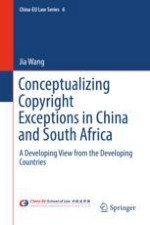2018 | OriginalPaper | Buchkapitel
2. An Overview of Copyright: A Balance of Interests
verfasst von : Jia Wang
Erschienen in: Conceptualizing Copyright Exceptions in China and South Africa
Aktivieren Sie unsere intelligente Suche, um passende Fachinhalte oder Patente zu finden.
Wählen Sie Textabschnitte aus um mit Künstlicher Intelligenz passenden Patente zu finden. powered by
Markieren Sie Textabschnitte, um KI-gestützt weitere passende Inhalte zu finden. powered by
